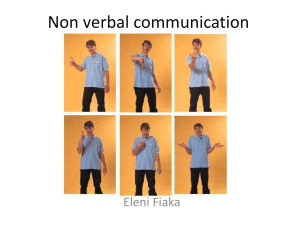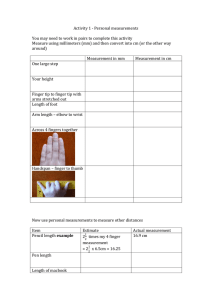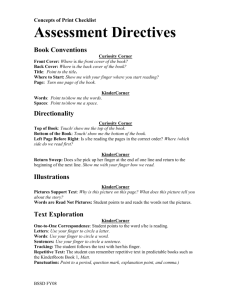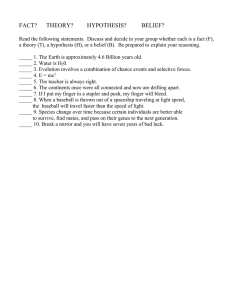Give your computer the finger: Touch-screen tech comes of age
advertisement
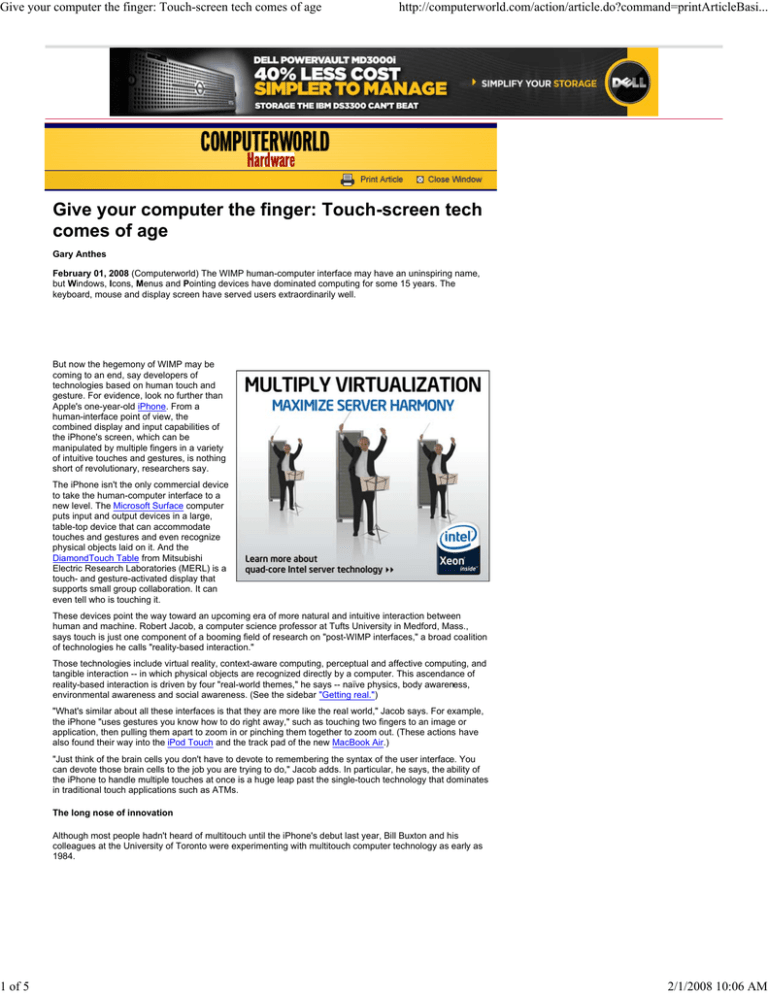
Give your computer the finger: Touch-screen tech comes of age 1 of 5 http://computerworld.com/action/article.do?command=printArticleBasi... Give your computer the finger: Touch-screen tech comes of age Gary Anthes February 01, 2008 (Computerworld) The WIMP human-computer interface may have an uninspiring name, but Windows, Icons, Menus and Pointing devices have dominated computing for some 15 years. The keyboard, mouse and display screen have served users extraordinarily well. But now the hegemony of WIMP may be coming to an end, say developers of technologies based on human touch and gesture. For evidence, look no further than Apple's one-year-old iPhone. From a human-interface point of view, the combined display and input capabilities of the iPhone's screen, which can be manipulated by multiple fingers in a variety of intuitive touches and gestures, is nothing short of revolutionary, researchers say. The iPhone isn't the only commercial device to take the human-computer interface to a new level. The Microsoft Surface computer puts input and output devices in a large, table-top device that can accommodate touches and gestures and even recognize physical objects laid on it. And the DiamondTouch Table from Mitsubishi Electric Research Laboratories (MERL) is a touch- and gesture-activated display that supports small group collaboration. It can even tell who is touching it. These devices point the way toward an upcoming era of more natural and intuitive interaction between human and machine. Robert Jacob, a computer science professor at Tufts University in Medford, Mass., says touch is just one component of a booming field of research on "post-WIMP interfaces," a broad coalition of technologies he calls "reality-based interaction." Those technologies include virtual reality, context-aware computing, perceptual and affective computing, and tangible interaction -- in which physical objects are recognized directly by a computer. This ascendance of reality-based interaction is driven by four "real-world themes," he says -- naïve physics, body awareness, environmental awareness and social awareness. (See the sidebar "Getting real.") "What's similar about all these interfaces is that they are more like the real world," Jacob says. For example, the iPhone "uses gestures you know how to do right away," such as touching two fingers to an image or application, then pulling them apart to zoom in or pinching them together to zoom out. (These actions have also found their way into the iPod Touch and the track pad of the new MacBook Air.) "Just think of the brain cells you don't have to devote to remembering the syntax of the user interface. You can devote those brain cells to the job you are trying to do," Jacob adds. In particular, he says, the ability of the iPhone to handle multiple touches at once is a huge leap past the single-touch technology that dominates in traditional touch applications such as ATMs. The long nose of innovation Although most people hadn't heard of multitouch until the iPhone's debut last year, Bill Buxton and his colleagues at the University of Toronto were experimenting with multitouch computer technology as early as 1984. 2/1/2008 10:06 AM Give your computer the finger: Touch-screen tech comes of age 2 of 5 http://computerworld.com/action/article.do?command=printArticleBasi... Bill Buxton demonstrates a touch-screen desk he helped develop at the University of Toronto in 1992. Click to view larger image Buxton, now a researcher for Microsoft Corp., says touch technology may be following a path similar to that of the mouse, which was co-invented by Douglas Engelbart in 1965 but did not reach a critical mass until the introduction of Windows 95 some 30 years later. Buxton calls these decades-long ramp-ups the "long nose of innovation," and he says they are surprisingly common. Touch now may be where the mouse was in about 1983, Buxton says. "People now understand there is something interesting here that's different. But I don't think we yet know what that difference could lead to. Until just one or two years ago there was a real separation between input devices and output devices. A display was a display and a mouse was a mouse." But now, he says, the idea that a screen can be bidirectional is on the cusp of catching on. "So now not only can my eye see the pixels, but the pixels can see my finger." Touch anywhere Although they have not gotten much traction in the marketplace yet, advanced touch technologies from IBM may point a way to the future. In its Everywhere Displays Project, IBM mounts projectors in one or more parts of an ordinary room and projects images of "touch screens" onto ordinary surfaces, such as tables, walls or the floor. A diagram of IBM's Everywhere Displays projection system. Click to view larger image Video cameras capture images of users touching various parts of the surfaces and send that information for interpretation by a computer. The touch screens contain no electronics -- indeed no computer parts at all -so they can be easily moved and reconfigured. A variation on that concept has been deployed by a wine store in Germany, says Claudio Pinhanez at IBM Research. The METRO Future Store in Rheinberg has a kiosk that enables customers to get information about the wines the store stocks. But the store's inventory was so vast customers often had trouble finding the particular wine they wanted on the shelf. They often ended up buying a low-margin wine in a nearby bin of sales specials, Pinhanez says. But now the kiosk contains a "show me" button which, when pressed, shines a spotlight on the floor in front of the chosen item. The spotlighted area is not yet an input device as described above, but it easily could be, Pinhanez says. IBM is also working on a prototype system for grocery stores that might, for example, illuminate a circle on the floor that asks, "Do you want to take the first steps toward more fiber in your diet?" If the customer touches "yes" with his foot, the system projects footsteps to the appropriate products -- high-fiber cereal, say. "Then you could make the cereal box itself interactive," Pinhanez says. "You touch it, and the system would project information about that box on a panel above the shelf." Asked if interactive cereal boxes might be a solution in search of a problem, Pinhanez says, "The point is, with projection and camera technology you can transform any everyday object into a touch screen." He says alternatives that are often discussed -- a store system talks to customers through their handhelds, for example -- are hard to implement because of a lack of standards for the devices. Getting real Tufts' Jacob has developed a framework that unites such disparate technologies as multitouch screens and systems that can read emotions from the faces of users. He says such "reality-based interaction" is based on these four concepts: Naive physics. It's common sense that tells people that an apple that comes off a tree will fall to the ground, even if they have forgotten Newton's laws. The Apple iPhone helps user intuition by simulating gravity (as when the screen switches from portrait to landscape mode as the user rotates the device) and inertia (e.g., when flicking through the contacts list, a fast flick will keep the contacts scrolling after the user's finger has been removed, as if the list had mass). Body awareness and skills. It's the ability -- learned very early in life -- to coordinate one's hands, eyes and senses independent of environment. "Emerging interfaces support an increasingly rich set of input techniques based on these skills, including two-handed and whole body interaction," Jacob says. Environmental awareness and skills. Humans naturally take actions in the context of objects in the environment. Emerging human-computer interaction styles -- such as virtual reality -- do the same. For example, 2/1/2008 10:06 AM Give your computer the finger: Touch-screen tech comes of age 3 of 5 http://computerworld.com/action/article.do?command=printArticleBasi... "context aware" or sensing systems may compute a user's location and take actions based on that. Social awareness and skills. People are aware of the presence of others and interact with them in various ways. Similarly, emerging technologies such as the Mitsubishi DiamondTouch Table facilitates collaboration via a touch display that allows users to maintain eye contact while interacting with the display simultaneously. Says Jacob, "All of these new interaction styles draw strength by building on users' preexisting knowledge of the everyday, nondigital world to a much greater extent than before." Tiny devices and the 'fat finger' problem Some researchers say that a logical extension of touch technology is gesture recognition, by which a system recognizes hand or finger movements across a screen or close to it without requiring an actual touch. "Our technology is halfway there," IBM's Pinhanez says, "because we recognize the gesture of touching rather than the occlusion of a particular area. You can go over buttons without triggering them." The occlusion problem, where a finger or hand blocks a user's view of what he's doing and leads him to make mistakes, is being attacked in some novel ways. Microsoft and MERL collaborated on development of a research prototype called LucidTouch, a two-sided, "pseudo-translucent" mobile device that allows users to issue commands with their fingers on either the front or the back of the device. "The problem we are addressing is what some people have called the 'fat finger problem,'" says Patrick Baudisch at Microsoft Research. When a user touches the back of the device, he sees an image of his fingers behind instead of in front of the things to be touched on-screen. LucidTouch can accept input from as many as 10 fingers at once. LucidTouch is particularly useful in two situations, Baudisch says: when multitouch interaction is desired, and when a touch screen is very small, perhaps as small as a watch face. He declined to say when or if LucidTouch might become a product, saying researchers would continue to perfect it while looking for applications such as mobile gaming, art and spreadsheets. Baudisch demonstrates a prototype LucidTouch device. Click to view larger images Asked about an extension of LucidTouch from touch to gesture recognition, Baudisch says the Microsoft prototypes already can act on finger gestures, with the system recognizing finger motions as well as positions and understanding the meaning of different numbers of fingers. For example, the motion of one finger is seen as equivalent to a mouse movement, a finger touch is interpreted as a click, and two fingers touching and moving is seen as a scroll command. Touch technology in its many variations is an idea whose time has come, Baudisch says. "It's been around a long time, but traditionally in niche markets. The technology was more expensive, and there were ergonomic problems," he says. "But it's all kind of coming together right now." The rise of mobile devices is a big catalyst, he says, with the devices getting smaller and their screens bigger. When a screen covers the entire device, there is no room for conventional buttons, he points out. And that will give impetus to other types of interaction, such as voice, he says. Microsoft's Surface computer. Click to view larger image Touch on a grander scale But not all the advances in touch technology are going into tiny mobile screens. Microsoft's Surface computer uses a two-way touch screen that is 30 inches across, big enough for several people to sit around and use simultaneously. It is intended to lie flat and present a 360-degree user interface. 2/1/2008 10:06 AM Give your computer the finger: Touch-screen tech comes of age 4 of 5 http://computerworld.com/action/article.do?command=printArticleBasi... Cameras embedded inside Surface sense user input in the form of touch and gestures (finger movements across the screen) and can capture the information needed to identify objects laid on it. This information is shipped to a garden-variety Windows Vista PC for processing and the results returned to Surface by a Digital Light Processing projector. It is a vision-based system, not capacitive or resistive as are many conventional touch devices. (See videos of Surface in action.) The art of touch Ico Bukvic, a professor of music technology at Virginia Tech in Blacksburg, has taken touch to an extraordinary level, using the Lemur multitouch "control surface" from the French company JazzMutant to compose and perform musical works on the fly, allowing a user to move his hands and fingers to "conduct" the music coming from a computer. Bukvic works with "interactive multimedia art," which can combine animation, video, recorded and on-the-fly electronic music, and other things in ways that enable the artist, the audience and the computer to work together in a "symbiotic circle," he says. The user can make an artistic presentation by controlling dozens of parameters -- video brightness, virtual camera position, sound pitch and amplitude, mix of instruments and so on -- with all 10 fingers, much as a pianist plays a complex piece while improvising on it. The parameters can be saved for later recreation of the performance in a "library of possible outcomes," Bukvic says. "It's like virtual Play-Doh, where each [finger] inflection affects the actual output -- aural, visual, etc. The composition and the performance become one." Microsoft is working with several commercial partners, including Starwood Hotels & Resorts Worldwide Inc., to introduce Surface, which is due to ship in the spring. It will initially target leisure, entertainment and retail applications, says Mark Bolger, director of marketing for Surface Computing. For example, he says, one could imagine a hotel guest using a "virtual concierge" in a Surface computer in the lobby to manipulate maps, photos, restaurant menus and theater information. Bolger says Surface has four defining characteristics, traits likely to be seen in many future touch-based devices: direct interaction (no keyboard or mouse), multitouch interface, multiuser input and object recognition -- for example, a waiter places a bottle of wine on Surface and it brings up pictures of the winery. Just what is meant by "multiuser" is a matter of some disagreement. Adam Bogue, vice president of business development at MERL, says MERL's DiamondTouch Table is the only truly multiuser touch device available because it is the only one that can identify different users who are touching it simultaneously. "Our whole approach has been to support small group collaboration," he says. With DiamondTouch, users literally become part of the system. Multiple antennas embedded under the surface transmit small radio-frequency signals to users' fingertips. Explains Bogue, "When you touch the table, you are capacitively coupling yourself to the signals, completing a circuit through you and into your chair. Each chair is wired into a separate receiver channel." (Watch a video of the DiamondTouch Table.) MERL's DiamondTouch Table. Click to view larger image MERL made its first DiamondTouch device in 2001 and has since sold more than 100 of them to university labs and to a few companies looking to incorporate the device into their own systems. The organization is now working on applications, the first ones in GIS and CAD, and it sells a kit of software and hardware that companies can use to develop their own applications. At the end of January, Bogue says, MERL will announce that it is spinning off the DiamondTouch business to an independent company to be called Circle Twelve Inc. Of course, researchers and inventors have envisioned even larger touch displays, including whole interactive walls. A quick YouTube search for "multitouch wall" shows that a number of these fascinating devices have reached the prototype stage, entrancing multitudes at technology conferences and in other public spaces. You can even buy one such device -- the Interactive Media Wall developed by multitouch innovator Jeff Han and his company Perceptive Pixel Inc. -- for $100,000 at Neiman Marcus. (Watch a video of the Interactive Media Wall.) But experts predict that this is just the beginning. Beyond touch Pradeep Khosla, professor of electrical and computer engineering and robotics at Carnegie Mellon University in Pittsburgh, says touch technology will proliferate, but not by itself. "When we talk face to face, I make eye gestures, face gestures, hand gestures, and somehow you interpret them all to understand what I am saying. I think that's where we are headed," he says. "There is room for all these things, and multimodal gestures will be the future." Microsoft's Buxton also anticipates a fusion of different interaction technologies. "There's been this notion that less is more -- you try to get less and less stuff to reduce complexity," he says. "But there's this other view that more is actually less -- more of the right stuff in the right place, and complexity disappears." In the office of the future, Buxton predicts, desktop computers might be much the same as they are today. "But you can just throw stuff, with the mouse or a gesture, up onto a wall or whiteboard and then work with it with your hands by touch and gesture standing up. Then you'll just pull things into your mobile and have this 2/1/2008 10:06 AM Give your computer the finger: Touch-screen tech comes of age 5 of 5 http://computerworld.com/action/article.do?command=printArticleBasi... surface in your hand. The mobile, the wall, the desktop -- they are all suitable for different purposes." Will that be the end of the WIMP interface? Tufts' Jacob advises users not to discard their keyboards and mice anytime soon. "They really are extremely good," he says. "WIMP almost completely dislodged the command-line interface. The WIMP interface was such a good invention that people just kind of stopped there, but I can't believe it's the end of the road forever." Buxton agrees. "WIMP is the standard interface going back 20-plus years, and all the applications have been built around that," he says. "The challenge is, without throwing the baby out with the bath, how do we reap the benefits of these new approaches while preserving the best parts of the things that exist?" 2/1/2008 10:06 AM


